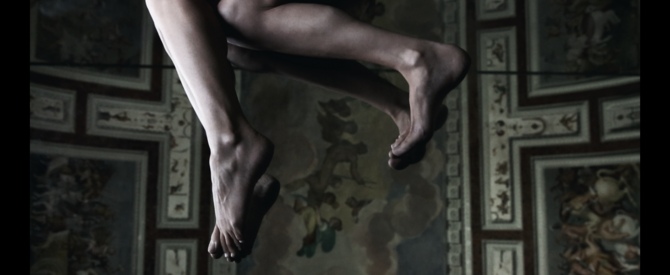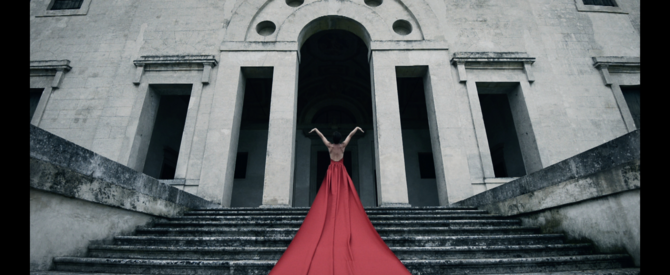
DMJ国際ダンス映画祭 2015
ダンス映画監督たちへのメールインタビュー
A Mail Questionnair to Dance Film Directors
今年の国際ダンス映画祭では、150を超える応募作の中から選ばれた作品がセレクションとして上映される。そのうち注目度の高い作品の監督に、広報担当の黒田が作品に関する疑問をぶつけた。製作の動機は、タイトルの意味は、撮影場所は、あのダンサーは誰か。実際の上映を観る前に読んでも良し、観た後に読んでも良しのQ&A。
The annual International Dance Film Festival screens the selected dance films by the festival curator out of over 150 entries from around the world. Here, we asked some questions to directors who created the selected dance films. What made you make this film? Meaning of the title? Where did you film this picture? Who is this dancer? etc. A Q&A good to read both before and after you see the films.
パラディオの朽ち木
監督 Michele Manzini
まず最初に、あなたについて教えてください。どういう作品を作ってこられましたか?
Michele Manzini : 私は「形態」をつくります。 形態というのは形を持つことへの挑戦です。真実が埋め込まれていても、知識として定着する前に華やかなだけで消えてしまう魅惑的な「印象」とは対照的なものです。 私の形態は不安定、矛盾、異質といったものを解決することも解消することもなく抱えているので、争いを内包しているといえるでしょう。 形態というのは古典哲学に敬意を払いながらもそれとは「別の考え」を形づくるということです。それは文学的「印象」とコンセプトを貫く思想でもあります。コンセプトの持つ抽象性と、神話や激情や類似や印象の持つ強固さという二つの「不完全な真実」を形態は取り持つのです。ムジール (※訳者註 Robert Musil 1880-1942 オーストリアの小説家)の言うように、形態とはこの二つの世界の中間に潜んでいます。
パラディオを調べたら16世紀のイタリアの建築家だということがわかりました。撮影場所は、彼が設計した建物なのでしょうか?なぜこの場所を選んだのですか?
Michele Manzini : 映画に登場する建築は1546年にアンドレーア・パラディオ(Andrea Palladio)によって設計された祈祷所(Villa Pojana)です。 この空間を パラディオ は、ある美の理想を信じることで、そのすべてを計算と数学とユークリッド幾何学にもとづく調和関係に目をつけて設計しました。この方法を用いれば偶然、障害、身体を通して知る現実、情熱が入り込む余地はありません。私はそんな場所を扱うことに大変な興味を持ちました。この建築と相容れない部分を持っているかもしれないイメージや、動作、シーケンスをその矛盾を解消も説明もすることもなく、明らかにしたかったのです。
タイトルの意味を教えてください。何がパラディオの「Snags(朽ち木)」なのでしょうか?
Michele Manzini : Snagとは障害の形のひとつです。そして障害こそ私たちが知識を体験することのできる方法の一つなのです。古代より、聡明な存在は身体を持っていませんでした。それは身体を放棄し、プラトンが言うような願望、欲情、要求がもたらす「野蛮な失態」による誤りから距離をとったのです。「いかにして身体とその体験から自由になるべきか?」私の考えではこれは西洋思想に組み込まれ、挑戦され続けてきたものの乗り越えることができていない問題なのです。
映像全体に幾何学的な印象を持ちました。ダンサーやその動きすらもここに巧みに組み込まれていると感じました。人体と振り付けをどのように意図して扱ったのですか?
Michele Manzini : 文章というものを作品を練り上げるための、基礎的な要素として考えています。作品と対峙する前に、まず書かなければいけません。分析もひとつの目的ですが、それは同時に内面や知性の説明でもあります。私はいつも謙虚な気持ちで論理的に書くことをしてきました。もしかするとこれは一般的な方法とは大きく違っているのかもしれません。文章は途中までは必要だけれど後から取り外すことが可能な、建設現場の足場のようなものだと考えています。私の理解では、最後に残るようにできているのは理論ではなく作業です。論理的に書くということが、少なくとも芸術の世界で目的としているのは成果を生むということです。その正しさよりも豊かさが問題なのです。この作品も例外ではありません。 作品のために書いた文章は製作に関わった全員と共有し、特にパフォーマーには多様なテーマについて語りました。振り付けを検討しはじめる前に、沢山のミーティングをしました。私たちは一緒に、辿るに値する細い糸をみつけたのです。
あなたが作品を作る時に、ロケーションと向き合うにあたって気をつけていることはありますか?
Michele Manzini : 私の作品はほぼ必ずといっていいほど空間と身体もしくは物体との関係、もしくはそこから読み取れるものを軸に作られています。なので私が使う空間が行き当たりばったりで選ばれるということはなく、私が何を求めているかやどんなテーマを扱いたいかに基づいて慎重に選定されています。

ENGLISH
Snags in Palladio
Director Michele Manzini
Please tell us about you, and what kind of pieces you have made in the past.
Michele Manzini : I create figures.Figures are an attempt at making a form and which I contrast with the fascination of images which, even though laden with truth, shine and then vanish without becoming knowledge.
My figures contain polemos in themselves, in the sense that they contain in themselves instability, conflict and otherness without dissolving or resolving it.The figure is the process of "another thought" with respect to that of classical philosophy, a thought that passes through literary "images" and concepts and that holds together two "half truths": the greatest abstraction of the concepts and the great strength of myths, unreasoning, analogies, and images.
As Musil has said, the figure dwells between these two worlds.
I found out that Palladio, is an Italian architect of the 16th century. Is the architecture in the film, one of his works? Why did you choose this location?
Michele Manzini : The architecture in the film is that of Villa Pojana, a design by Andrea Palladio dating from 1546.
Palladio constructed those spaces by following an ideal model of beauty that foresaw the use of harmonious relationships completely based on calculations, mathematics, and Euclidian geometry. In this model there is no space for chance, error, or for a knowledge of reality arrived at through the body or the passions. It was for this reason that I was extremely interested in undertaking a work in those places in search of a definition of images, gestures, and sequences that might hold within them a conflict with this architecture, without explaining or resolving it.
Please tell us the meaning of the title. What exactly are ‘snags’?
Michele Manzini : A snag is one of the many forms of error, and error is one of the many ways in which we can experience knowledge. Since antiquity a subject who is knowledgeable is a subject who has no body, who has renounced the body and thus keeps his distance from the errors that, as Plato said, are caused by the "barbaric slush" of our desires, passions, and needs. According to me this has been an insuperable problem in the history of Western thought which has always tried to deal with the same problem: how to be freed from the body and the experience of the body.
Whole of the film had the impression of being beautifully geometrical, even the dancers’ and their moves. How did you direct the human bodies and the choreography in this piece?
Michele Manzini : In elaborating my work the text is a basic element. Before arriving at a completed work I need to face up to writing, and this is both a means of analysis but also of an inner and intellectual clarification. I have always devoted myself to theoretical writings in a humble way and, perhaps, with an approach that is very different from the usual one. I have always considered them as the scaffolding that we use for construction but which afterwards it is convenient to remove. As far as I am concerned, what is destined to remain is not the theory but the work. The judgment that theoretical writing aims for, at least in art, concerns this ability to bear fruit: its fertility rather than its truth. And this work is no exception. I shared the texts of the project with all those who have collaborated with me, in particular with the performers with whom I talked a great deal about various themes. There were very many meetings before beginning the research into gestures. I can say that together we found a slender thread which we could follow.
When you create your works, are there any policies you have on filming locations and how to handle them?
Michele Manzini : My works are almost always constructed on the relationship between space and bodies or objects: on what that relationship can tell me. For this reason, my choice of spaces is never random, but chosen with great attention on the basis of what I am looking for and on the themes I want to work on.




